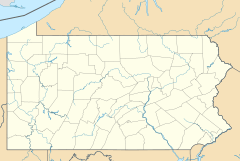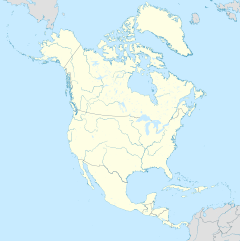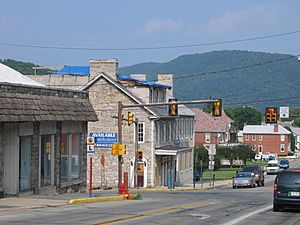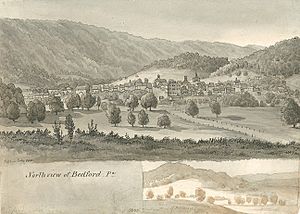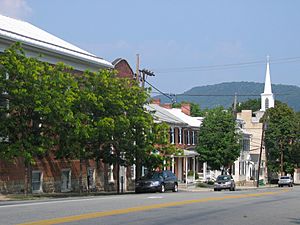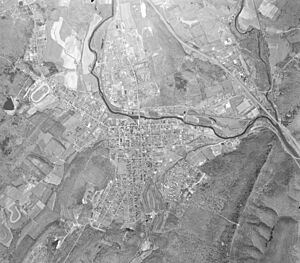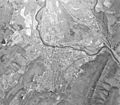Bedford, Pennsylvania facts for kids
Quick facts for kids
Bedford, Pennsylvania
|
|
|---|---|
|
Borough
|
|
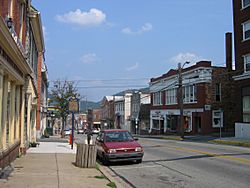
East Pitt Street in Bedford
|
|
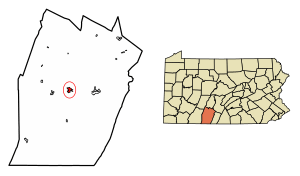
Location of Bedford in Bedford County, Pennsylvania (left) and of Bedford County in Pennsylvania (right)
|
|
| Country | United States |
| State | Pennsylvania |
| County | Bedford County |
| Settled | 1751 |
| Laid out | 1766 |
| Incorporated | March 13, 1795 |
| Area | |
| • Total | 1.11 sq mi (2.88 km2) |
| • Land | 1.08 sq mi (2.81 km2) |
| • Water | 0.03 sq mi (0.07 km2) |
| Elevation | 1,100 ft (300 m) |
| Population
(2020)
|
|
| • Total | 2,865 |
| • Density | 2,640.55/sq mi (1,019.45/km2) |
| Time zone | UTC−5 (EST) |
| • Summer (DST) | UTC−4 (EDT) |
| ZIP Code |
15522
|
| Area code(s) | 814 |
| FIPS code | 42-04944 |
|
Pennsylvania Historical Marker
|
|
| Official name: Bedford Village | |
| Designated: | November 6, 1982 |
| Top - 0-9 A B C D E F G H I J K L M N O P Q R S T U V W X Y Z |
Bedford is a small town, also called a borough, in Pennsylvania, USA. It is the main town of Bedford County. Bedford is known as a "spa town" because of its famous natural springs.
This historic town is about 102 miles (164 km) west of Harrisburg, the state capital. It is also 107 miles (172 km) east of Pittsburgh. In 2020, about 2,865 people lived in Bedford.
History of Bedford
Early Settlers and Fort Bedford
People from Europe and America started trading in the Bedford area in the late 1740s. More settlers arrived after 1758. This was when the Forbes Road was built. It helped the Forbes Expedition in their fight against Fort Duquesne.
In 1758, the British Army came to the area. They were led by General John Forbes. They built Fort Bedford at John Ray's trading post. This fort was a key place to store supplies. It was part of a chain of forts between Carlisle and the Allegheny River. The fort was named after John Russell, the 4th Duke of Bedford. The town of Bedford later got its name from this fort.
Fort Bedford was important for controlling fur trading. It also protected settlers during the American Revolutionary War. It was a safe place when Native American groups raided the area.
A Myth About the Fort
There is a story that American rebels called "Black Boys" captured Fort Bedford. This was supposedly ten years before the American Revolution. However, this story is not true. The British Army had already left the fort in 1766. This was after Pontiac's Rebellion ended.
The "Black Boys" raid happened in 1769. A group of men attacked a supply train. They took weapons and other goods. These men were put in prison. So, James Smith and his followers attacked the fort. Only local settlers were guarding it. The attackers freed the prisoners. They also took more firearms before leaving.
Founding the Town
In 1766, John Lukens planned out the village of Bedford. It officially became a town on March 13, 1795. Because of some paperwork problems, the town had to be made official again in 1816.
The original Fort Bedford eventually fell apart. In 1958, a building like one of the fort's old blockhouses was built. This building is now the Fort Bedford Museum. The actual fort was never rebuilt.
The Whiskey Rebellion
In 1794, President George Washington brought 13,000 soldiers near Bedford. They came to stop the Whiskey Rebellion. This rebellion started because of a tax on whiskey. The soldiers gathered near Jean Bonnet Tavern, west of Bedford. President Washington stayed at the Espy House in Bedford.
Farmers were upset about the tax. They found it easier to transport whiskey than grain. The uprising grew, so Washington acted quickly. He wanted to show that federal laws must be followed. One historian said that in Bedford, the new government showed its power.
Bedford's Healing Springs
In the 1800s, Bedford County became famous for its special springs. These springs were believed to have healing powers. Three resorts grew up around them: Bedford Springs, Chalybeate Springs, and White Sulphur Springs.
The Bedford Springs Resort opened in 1806. It was started by Dr. John Anderson. This resort became very popular. It had different types of mineral springs. Visitors came hoping to get better from various sicknesses.
President James Buchanan used Bedford Springs as his "summer White House." In 1858, he received the first message from the first trans-Atlantic cable there. This message was from Queen Victoria. In 1855, the resort also hosted the only U.S. Supreme Court meeting ever held outside of Washington, D.C.
Other famous people stayed at these resorts. These included Presidents William Henry Harrison, James Polk, Zachary Taylor, Rutherford B. Hayes, and Benjamin Harrison.
Modern Landmarks
U.S. Route 30, also known as the Lincoln Highway, goes through Bedford. Before the Pennsylvania Turnpike opened in 1940, Route 30 was the main road from Philadelphia to the west.
In 1927, a unique building shaped like a coffee pot was built in Bedford. It was originally a diner. This landmark was moved to the Bedford County Fairgrounds in 2003.
The Bedford Historic District was added to the National Register of Historic Places in 1983. This means it is a special place worth preserving.
Geography of Bedford
Bedford is located in the middle of Bedford County. It is completely surrounded by Bedford Township.
You can reach the town from Exit 146 of the Pennsylvania Turnpike. This is halfway between Harrisburg and Pittsburgh. U.S. Route 220 is a four-lane highway that goes around Bedford to the west. North of town, it becomes Interstate 99. US-220 Business goes through the center of Bedford as Richard Street.
The Raystown Branch of the Juniata River flows through Bedford. This river is a branch of the Susquehanna River.
Bedford covers about 1.11 square miles (2.88 square kilometers). A small part of this area, about 0.03 square miles (0.07 square kilometers), is water.
Fun Events in Bedford
Fall Foliage Festival
Every year, Bedford hosts a Fall Foliage Festival. It happens on the first two weekends of October. The festival takes place on Penn Street, Juliana Street, and in the park near the Fort Bedford Museum.
At the festival, you can find many vendors selling things. You can also tour the fort and watch the Children's Theater. There are pony rides and a show of antique cars. A Fall Foliage Queen is crowned each year. Girls from local high schools compete for scholarship money.
Bedford County Fair
The Bedford County Fair happens every year in July or August. It has classic carnival rides, games, and food. There are also many events sponsored by 4-H clubs. These include animal shows and livestock auctions. You can also watch car racing and demolition derbies. These take place at the Bedford Fairgrounds Speedway. There is also a petting zoo where you can meet animals.
People of Bedford
Bedford is home to about 2,865 people. The town has a mix of families and single people. The average age of people living in Bedford is about 49.5 years old.
Most people in Bedford have finished high school. Many also have a college degree. The town's economy is supported by local businesses and visitors.
Economy of Bedford
Bedford has some important businesses. These include Walmart and JLG Inc. distribution centers. Their location near major highways helps them.
The Omni Bedford Springs Resort is also a big part of the economy. It is just 5 miles (8 km) from downtown. This resort brings in many visitors each year. These guests help support local shops and restaurants.
The Bedford County Airport also helps the local economy. In 2022, it brought in over $8,000,000 and created 55 jobs.
Transportation in Bedford
The Bedford County Airport is a public airport. It is owned by the Bedford County Airport Authority. The airport is about four nautical miles (7.4 km) north of the center of Bedford.
Media in Bedford
Magazines
- Hometown Magazine
Newspapers
- Bedford Gazette
Television
Bedford gets its TV channels from the Johnstown-Altoona-State College, Pennsylvania area.
Radio
Six radio stations broadcast in Bedford:
- WBFD - 1310 AM
- WRAX - 1600 AM
- W254DF - 98.7 FM (plays WBFD)
- WAYC - 100.9 FM
- W293DF - 106.5 FM (plays WRAX)
- WBVE - 107.5 FM
Notable People from Bedford
- William Mann Irvine, who started Mercersburg Academy
- Lawrence Taliaferro, a U.S. diplomat
- John Tod, a U.S. Congressman
- George Washington Williams, a historian, clergyman, and soldier
- Henry Woods, another U.S. Congressman
See also
 In Spanish: Bedford (Pensilvania) para niños
In Spanish: Bedford (Pensilvania) para niños
Images for kids
-
Location of Bedford in Bedford County, Pennsylvania (left) and of Bedford County in Pennsylvania (right)


